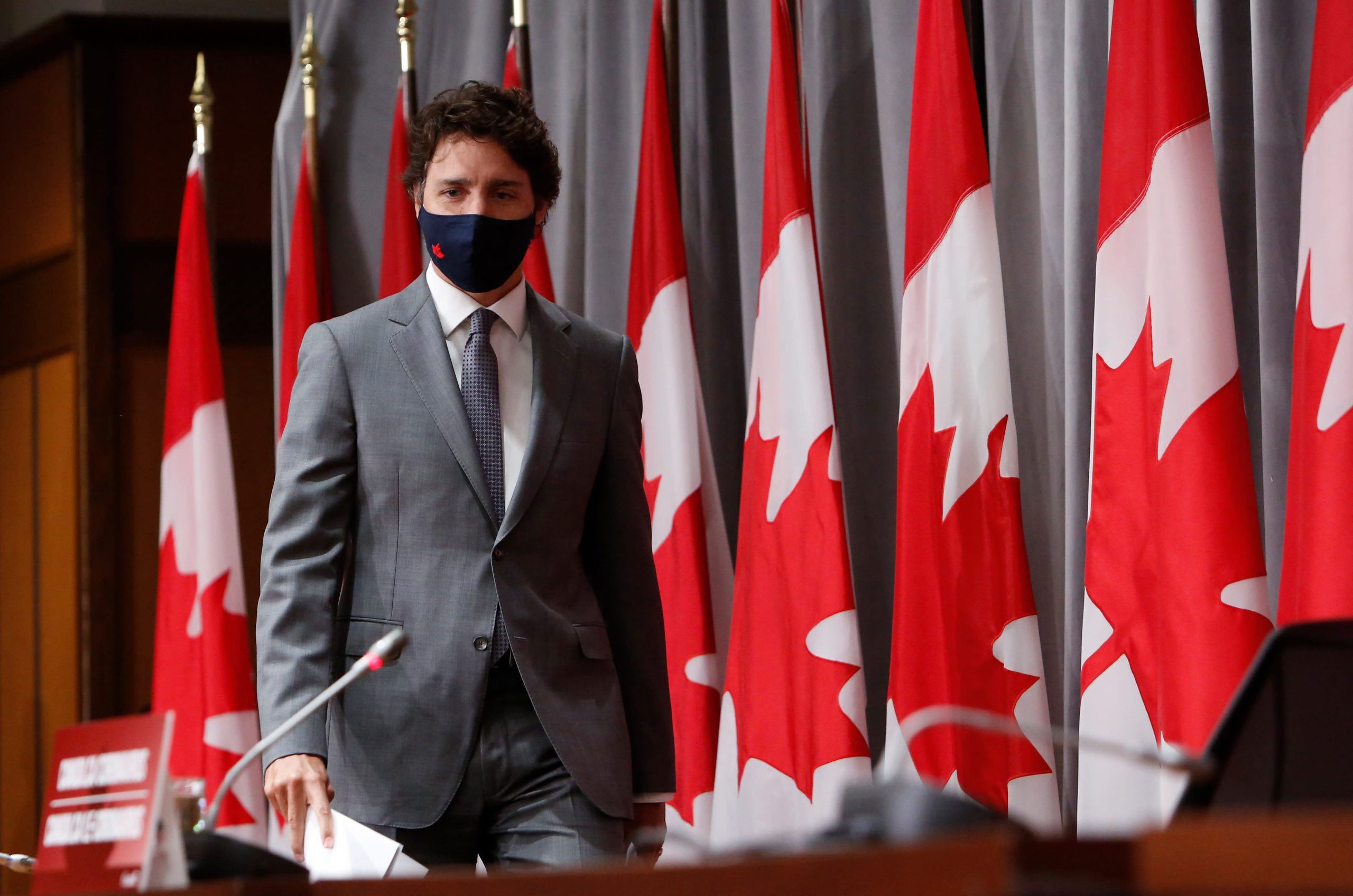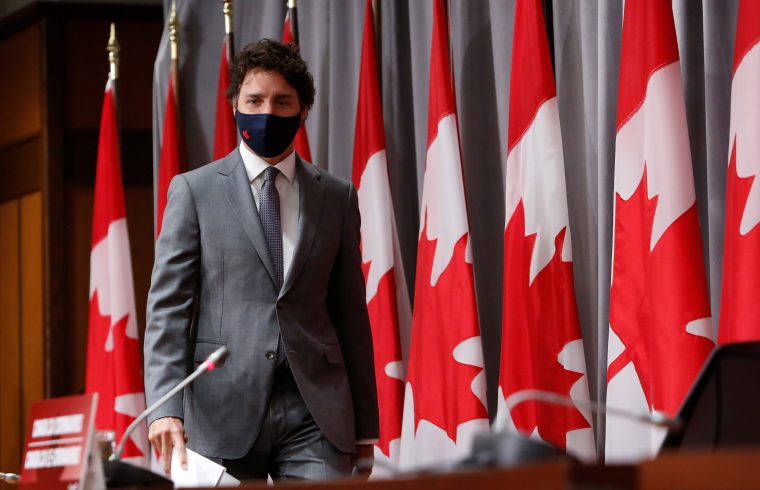
Justin Trudeau, Canada’s prime minister, wears a protective mask while arriving for a news conference in Ottawa, Ontario, Canada, on Wednesday, July 8, 2020.
David Kawa | Bloomberg | Getty Images
CNBC is looking at how countries around the world have tackled Covid-19. By talking to a wide range of experts, as well as everyday citizens, we’re taking stock of what’s gone well — and what hasn’t. So far, there have been more than 10 million cases worldwide of Covid-19 and more than 500,000 people have died, according to data from Johns Hopkins University. The United States has reported more than 3 million cases and more than 130,000 deaths, the most of any country. Canada, the first country in our series, has confirmed more than 105,000 cases with more than 8,000 deaths.
What has been going well
Hospital preparedness
Many of Canada’s leading hospitals were generally prepared for an influx of Covid-19. There were initial concerns about a lack of personal protective equipment back in April, but the country quickly ramped up production. Earlier this month, Prime Minister Justin Trudeau noted that Canadian companies are producing so much PPE to fight Covid-19 that the country is almost at the point of being self-sufficient.
“We did really quickly retool our manufacturing supply chain,” said Zayna Khayat, a health strategist at Toronto-based SE Health and an adjunct professor of health sector strategy at the Rotman School of Management at the University of Toronto. “We never had domestic capacity for things like masks, gowns and vents, so it’s been good to see us get there.”
A man waves a Canadian flag as first responders parade down hospital row in Toronto, Ontario, Canada, in a salute to healthcare workers on April 19, 2020, amid the novel coronavirus pandemic.
Cole Burston | AFP | Getty Images
“Covid-19 is ongoing, but so far the hospitals have never gotten that saturated,” added Dr. Zain Chagla, an associate professor at McMaster University and an infectious disease physician. Even in cities with the most Covid-19 cases, like Toronto, doctors are reporting that the situation doesn’t mirror Italy, where hospitals were overwhelmed and couldn’t maintain the standard of care.
The cult of Bonnie Henry
Dr. Bonnie Henry, a physician and the provincial health officer of British Columbia, has become a kind of folk hero in Canada during the crisis. “She stands out for really clear messaging and her empathy. When she announced the first death in Canada, she was overcome with emotion,” said Andre Picard, a health columnist for The Globe and Mail.
British Columbia Minister of Health Adrian Dix and Dr. Bonnie Henry, provincial health officer, speak to the media on the novel coronavirus in Vancouver, British Columbia, January 31, 2020.
Don Mackinnon | AFP | Getty Images
Henry has become such a figurehead that when a Vancouver-based shoe company learned that she was a fan, they put out a limited-edition release of shoes to honor her.
Public health experts note that it’s important to have a spokesperson who can regularly speak to people about the pandemic in a consistent way. Henry, at least so far, has all the qualities that public health departments typically look for in a public face. Many people find her soft voice to be comforting, and she’s taken time to remind Canadians to be good to each other and to come together in the face of a unified threat. She typically ends her calls and presentations with a trademark line: “This is our time to be kind, to be calm and to be safe.”
Most important, her communication style seems to be working. British Columbia could have experienced a major outbreak, given that a large chunk of its population travels back and forth to China. But public health experts note that it’s been manageable. Thus far, there have been a little more than 3,000 reported Covid-19 cases and less than 200 deaths in the province. “If you look at British Columbia, with its population of millions of people, the fact that they came out relatively unscathed from Covid-19 is a huge testament to her leadership,” said Chagla.
The bravery of Canada’s providers
Healthcare workers cheer as Toronto first responders parade down hospital row in Toronto, Ontario, Canada, in a salute to healthcare workers on April 19, 2020, amid the novel coronavirus pandemic.
Cole Burston | AFP | Getty Images
Similarly to other countries, Canada has seen hundreds of its medical providers get sick with Covid-19. Ontario, in particular, is reporting rising cases among heath-care workers. Doctors and nurses have spoken out to the local press referring to the situation as scary and alarming, but many are continuing to treat patients despite the risks. Some workers in long-term care facilities have died from the virus.
“It’s the job, we go in,” said Dr. David Fisman, an epidemiologist and professor at the Dalla Lana School of Public Health at the University of Toronto, when asked about the contribution of the country’s health-care workers.
“There are so many stories of courage and kindness on the front lines,” added Dr. Andrew Boozary, an assistant professor of public health at the Dalla Lana School of Public Health.
What’s been pretty good
Economic relief
People enjoy drinks and food at Amsterdam Brewhouse’s patio, as the provincial phase 2 of reopening from the coronavirus disease (COVID-19) restrictions begins in Toronto, Ontario, Canada June 24, 2020.
Carlos Osorio | Reuters
Experts say that Canada’s economic relief package — and its safety net in general — is more robust than what the U.S. has offered.
Canadian residents may apply for up to $ 2,000 in direct monthly payments for a four-month period. That program was open to those who had lost their job or couldn’t work because of Covid-19, but has now been expanded to those who earn up to $ 1,000 per month.
Similarly to the U.S., there were delays with the system, at least initially, but most of the experts agreed that the program has done a lot to support those impacted by the pandemic.
“I am not an economist but the federal transfer program seems to have kept our economy going along OK,” said Fisman, the Toronto epidemiologist . “As provinces have controlled their epidemics they have started making new jobs (and) I do think there is a renewed sense of needing to onshore some manufacturing.”
“We did a good job ensuring that people had enough financial means to live through lockdowns,” added Tazim Virani, an assistant clinical professor at McMaster University. All in, the relief will provide $ 27 billion in direct support to Canada’s citizens and its businesses.
Clear-ish communication
“I think we’re a culture of followers,” said Picard, “but we need clear rules to follow, at least in public spaces.”
The messaging has been “wishy-washy” added Picard. Some blame the fact that Canada’s health system functions at a provincial level, rather than at a national level, so guidelines differ across the country.
Canada’s Prime Minister Justin Trudeau removes his face mask as he visits the Big Rig Brewery, which utilizes the Canada Emergency Wage Subsidy given to businesses affected by the coronavirus disease (COVID-19) outbreak, in Kanata, Ontario, Canada June 26, 2020.
Patrick Doyle | Reuters
Yoni Freedhoff, an associate professor of family medicine at the University of Ottawa, said that regions are setting their own guidelines on wearing masks. In certain areas, these are mandatory where social distancing can’t be maintained, and in others mask wearing is advised but not enforced. Some public health experts feels this policy makes sense, because there aren’t active Covid-19 outbreaks across the country, but others say there should be consistent rules everywhere.
Travel restrictions
Canada issued a travel ban on March 20 for visitors from the U.S. Since then, thousands have been turned away at the border, particularly those traveling for nonessential reasons. That ban is set to continue until July 21, but it isn’t a total ban. Health-care workers are still able to move between the two countries, as well as foreign workers and people with immediate family in Canada visiting for nondiscretionary reasons.
The government has been stricter in recent months about travel, and is now advising against any nonessential trips, but some Canadians feel that the restrictions should have come sooner than mid-March. “We didn’t close borders quickly enough,” noted Freedhoff, the family medicine physician.
Trucks traverse the Ambassador Bridge, a main trade route linking Canada and the United States, as coronavirus disease (COVID-19) restrictions remain in place, in Windsor, Ontario, Canada July 5, 2020.
Carlos Osorio | Reuters
Fisman, the epidemiologist, agrees that the federal government could get tougher on enforcing the border. But he notes that it’s very difficult to restrict movement from the U.S., as people usually find ways to get places when they want to. In addition, the economies of Canada and the U.S. are extremely intertwined. All in, he believes the travel restrictions came at about the right time, given what was known at that stage.
What’s been disappointing so far
Nursing homes
Canada’s health-care system is publicly funded, so care is covered by tax dollars. But the long-term care system relies on a mix of public and private payments, and some people are paying out of pocket. The Commonwealth Fund, a global health research nonprofit, reports that out-of-pocket payments still represent about 15% of overall health spending, and much of that was spent on nonhospital institutions including long-term care homes.
50 crosses have appeared on the side lawn of the Camilla Care Community nursing home on Hurontario at the Queensway. 50 of their residents have died there due to a COVID outbreak.
Richard Lautens | Toronto Star | Getty Images
“It exposed a longstanding problem in that sector,” said Picard, the columnist. “It’s not a system and it’s not properly funded, and there’s both poor pay and chronic staffing problems.”
Many of the deaths in Canada have been residents of nursing homes. By mid-April, that population alone represented more than half of the overall fatalities, and horrifying reports circulated about abandoned, desperately ill patients. Most of the experts agreed that this is an opportunity for Canadians to reevaluate how they take care of their aging residents.
“It’s been damning,” said Boozary. “We have come out of this as a country knowing that we have failed the residents of our long-term care homes.” Boozary said that he hopes that Canada emerges from the epidemic with a much better strategy for how to fund care for elderly residents, as well as how to staff facilities.
Migrant workers and inmates
Similarly to the U.S., the pandemic has disproportionately affected Canada’s most vulnerable residents.
Some provinces reported outbreaks in prisons, and about 600 migrant workers tested positive on a farm in Canada after arriving in the country in the spring. The government has restricted travel, but it did allow foreign workers to come into the country before picking and growing season. Some workers told CNN earlier this month that the quarantine was poorly handled, and employers put them in risky situations.
“The most recent blowup here has been around miserable treatment of migrant farm workers, who are housed in dormitories and have had big Covid outbreaks,” said Fisman. According to Fisman, government health officials could be doing a lot more to protect these workers, including to separate them and stop them working if they start experiencing symptoms.
Masks and testing in Ontario
Women get their nails done, as the provincial phase 2 of reopening from the coronavirus disease (COVID-19) restrictions begins in Toronto, Ontario, Canada on June 24, 2020.
Carlos Osorio | Reuters
Ontario, a province in Canada, reported a drop in daily tests throughout April, despite seeing an uptick in deaths. That proved to be a worrying trend. In May, news broke that more than 55 million N95 masks stockpiled by Ontario had expired, which raised yet more questions about the readiness to tackle the pandemic.
“There were clearly organizational and political issues,” said Fisman.
Overall in Canada, just two provinces — Ontario and Quebec — have accounted for more than 90% of the country’s Covid-19 cases.
How Canada scores overall: 6.5/10
We asked every expert we spoke to for their score out of 10 (1 is the extremely poor and 10 is ideal). It’s an extremely subjective measurement, but the average across all of them is 6.5. Some provinces, like British Columbia, scored far higher than others, including Quebec and Ontario.
As Picard put it, many Canadians took heart that the response was better than the U.S. across a variety of fronts, but they recognized that the country was “no Australia.”







